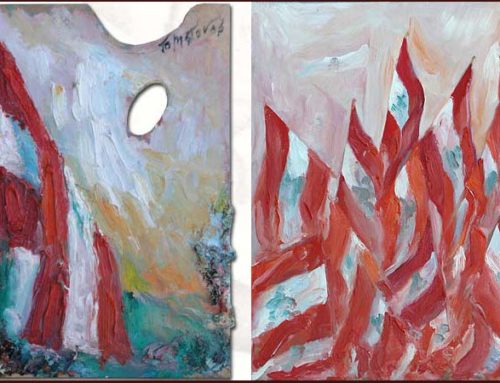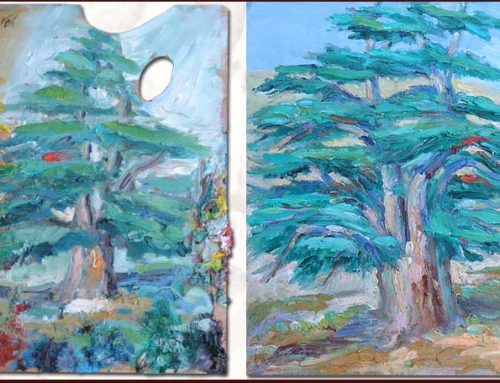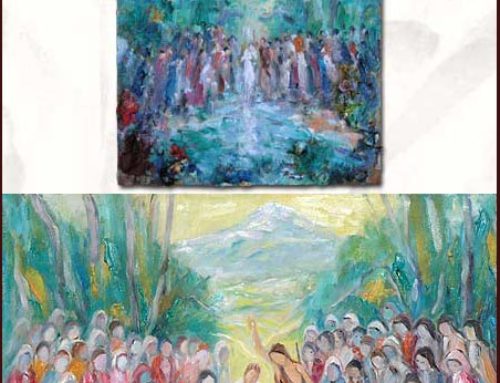Art Comment Quarterly ArtVitae.com – Summer 2003
Pity the Nation
“Pity the nation that is full of beliefs and empty of religion. Pity the nation that wears a cloth it does not weave, eats a bread it does not harvest, and drinks a wine that flows not from its own wine-press. Pity the nation that acclaims the bully as hero, and that deems the glittering conqueror bountiful. Pity a nation that despises a passion in its dream, yet submits in its awakening. Pity the nation that raises not its voice save when it walks in a funeral, boasts not except among its ruins, and will rebel not save when its neck is laid between the sword and the block. Pity the nation whose statesman is a fox, whose philosopher is a juggler, and whose art is the art of patching and mimicking. Pity the nation that welcomes its new ruler with trumpeting, and farewells him with hooting, only to welcome another with trumpeting again. Pity the nation whose sages are dumb with years and whose strong men are yet in the cradle. Pity the nation divided into fragments, each fragment deeming itself a nation.”
Kahlil Gibran (1883-1931)
A Broader Perspective
Whether it be in relation to the persecution of the Jews during the Holocaust years, or to the current animosity propagated toward Arabs, it seems to be a sad indictment of human nature that during times of global conflict it is all too easy for us to dehumanise and even demonise whole races of our fellow human beings. Some might say that this human compunction toward racial prejudice is a natural evolutionary instinct spawned during primordial times when tribalism meant survival. Or perhaps it is more the result of simple ignorance.
Those of us in the Western World, with our internet, atomic bombs, and moon landings, can feel smugly superior to the Peoples of the Middle East. However, in the grand scheme of history, these modern triumphs could be perceived as miniscule in comparison to the earthshaking human developments accredited to Middle Eastern peoples. Where would our moon buggies be without the invention of the wheel and astronomy? Where would the internet be without the invention of writing? Where would atomic power be without mathematics and algebra (what could be more Arabic sounding than Al-Gebra)?
And what good do we do with all this modern technology? What guides us in the fair and proper use of this power that man has somehow appropriated for himself from the Gods? We seek these answers in Religion, and Philosophy. Again, like the technologies described above, our sources for spiritual guidance, the great monotheistic religions of the Western World, are also a product of the cultures of the Middle East.
Those in the West also tend to ignore or forget the great poets and artists of the Middle East. Artist, poet, and philosopher, Kahlil Gibran (see poets section) quoted in the introductory paragraph above, is a Middle Eastern version of, and is at least equal in stature to, English artist William Blake. And yet, how many Westerners have heard of Gibran?
One contemporary Middle Eastern artist/poet is Joseph Matar . His heroic painting Kadmous depicts King Kadmous of Byblos of the second millennium BC. Kadmous is credited with the invention and spread of the Phoenician alphabet, the direct precursor to Greek and Amaric (known to Biblical scholars as the alphabet used in the Dead Sea Scrolls and also during the life of Christ). The Phoenician alphabet evolved over the millennia into every Western alphabet used today. The homage afforded to Kadmous of Byblos by scholars through the ages for his contribution to language is still evidenced in words like: Bible, bibliography, and etc. -all derived from the root word ‘Byblos’.
Matar’s painting Ahiram et le Temple relates the story of the destruction of the Temple of Solomon. The Old Testament of the Bible refers to King Hiram (Alhiram) the Canaanite (Phoenician) king. Hiram was the architect of and sent his masons and labourers to Jerusalem to build the great Temple of Solomon which was infamously destroyed by Nebuchadnezzar’s Assiryans armies. (The Hebrew word for Canaanite, kena’ai means merchant. The Phoenicians were among the earliest navigators and world merchants, and thus spread their influence on culture and civilization throughout the world.)
A curious symbol used in both of Matar’s paintings is the five-pointed star. The casual viewer can be forgiven for identifying the star depicted on the temple wall in his painting of the Ahiram et le Temple, as the six-pointed Star of David, symbol of the modern state of Israel. But closer inspection reveals that the star is a five-pointed star, the iconical symbol of the Phoenician dynasties. The great Phoenician architect King Kadmous is also credited with the creation of the Freemasons who still use the five-pointed star as the symbol of this secretive and powerful organisation (almost every US president has been a member of the Freemasons). The Greek Pythagorians also embraced and promulgated that mystical Phoenician star upon which they attributed great powers. The proportions and geometry of that star and its pentagonal derivatives are still studied and utilized in certain academic artistic circles in the form of the ‘Golden Mean’. (As a result of various religious iconoclastic inquisitions over the ages, the five-pointed star has unfortunately also been associated with the Occult.) Morocco, originally a Phoenician colony, proudly displays the Phoenician star on its national flag.
Matar’s work and the works of all artists worldwide can help us to understand cultures foreign to us and hopefully, lead us not to reject, marginalize, and destroy them; but, to welcome and embrace them.







